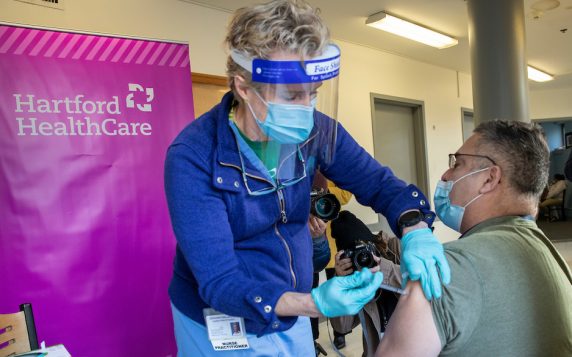Science rarely gets in the way of people who argue against wearing masks during the pandemic. When it does, they often site a lack of hard scientific evidence — randomized clinical trials that designate participants randomly into a control group or intervention group.
But now a randomized trial that included close to 350,000 people in rural Bangladesh has shown that masks, specifically surgical masks, reduce COVID-19’s spread. The findings, published as a preprint study earlier this month by the nonprofit Innovations for Poverty Action, show the real-world effects of masks particularly in countries where vaccines are not yet widely available. But even in the United States, this study led by researchers from Yale and Stanford universities adds solid foundational evidence to support both mask-wearing and, where necessary, mask mandates.
“It’s not just about the vaccine or masking or social distancing,” says Dr. Ulysses Wu, Hartford HealthCare’s System Director of Infection Disease and Chief Epidemiologist. “It’s all of them.”
For the mask study, now undergoing peer review, researchers tracked 342,126 adults in 600 Bangladesh villages for five months starting last November after selecting villages randomly to begin a program offering free masks and information about their use and effectiveness. Mask use increased by almost 30 percent among the 178,000 people in those villages, lasting at least 10 weeks. Researchers later reported an 11.9 percent decrease in symptomatic COVID-19 and a 9.3 percent drop in the presence of the virus in blood samples.
If a 30 percent increase in mask usage with not quite a 12 percent drop in infections doesn’t sound like much, try folding those numbers into 100 percent usage and, theoretically, close to a 100 percent drop in cases. Researchers found only a 9 percent drop in symptomatic cases among the intervention (masks) group compared to the control (maskless) group, likely because people without symptoms or whose symptoms did not satisfy the World Health Organization’s definition of the disease were not tested.
Surgical masks were the study’s big winner, producing an 11 percent reduction in risk of infection compared with villages where masks were not worn, with cloth masks reducing risk by 5 percent. Laboratory experiments later produced comparable results. Even after 10 washes, surgical masks still filtered 76 percent of small particles capable of airborne transmission of the virus.
“Indoors, when you’re with people you don’t know — I’m talking about public areas — it’s a good idea to wear a mask right now,” says Dr. Virginia Bieluch, Chief of Infectious Diseases at The Hospital of Central Connecticut in New Britain.




